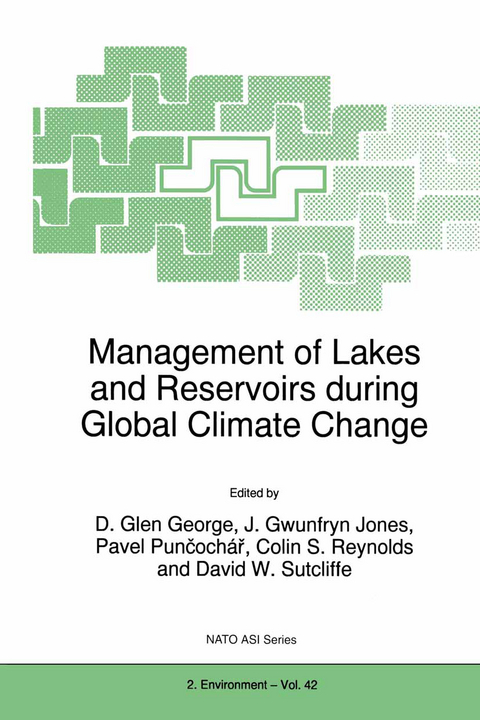
Management of Lakes and Reservoirs during Global Climate Change
Springer (Verlag)
978-94-010-6085-1 (ISBN)
If present trends continue, most climatologists agree that the concentration of carbon dioxide in the atmosphere will have doubled by the year 2050. This increase in CO 2 will have a major effect on the global climate and substantially alter the physical, chemical and biological characteristics of lakes throughout the world. In recent years, it has become clear that year-to-year changes in the weather have a major effect on the seasonal dynamics of lakes. Many water quality problems that were once regarded as "local" phenomena are now known to be influenced by changes in the weather that operate on a regional or even global scale. For example, blooms of toxic blue-green algae can be induced by prolonged reductions in the intensity of wind-mixing as well as increased supplies of nutrients. Long-term studies in the English Lake District have shown that many of these variations are quasi-cyclical in nature and can be related to long-term changes in the distribution of atmospheric pressure over the Atlantic Ocean. It is not yet clear what effect these changes have on the dynamics of European lakes but much of the historical data required to extend these analyses to continental Europe is already available. In the early 1970s the International Biological Programme served as a particularly effective focus for comparative limnological research in eastern as well as western Europe.
Changes in atmospheric circulation and climate over the North Atlantic and Europe.- Linkages between atmospheric weather and the dynamics of limnetic phytoplankton.- The influence of weather conditions on the seasonal plankton development in a large and deep lake (L. Constance). I. The impact of irradiance, air temperature and wind on the algal spring development — an analysis based on long-term measurements.- The influence of weather conditions on the seasonal plankton development in a large and deep lake (L. Constance). II. Water column stability derived from one-dimensional hydrodynamical models.- The influence of weather conditions on the seasonal plankton development in a large and deep lake (L. Constance). III. The impact of water column stability on spring algal development.- The influence of weather conditions on the seasonal plankton development in a large and deep lake (L. Constance). IV. The response of crustacean Zooplankton to variations in water temperature and algal growth in spring and early summer.- Fluctuations of phytoplankton prodcuction and chlorophyll concentrations in a small humic lake during six years (1990–1995).- Sudden and gradual responses of phytoplankton to global climate change: case studies from two large, shallow lakes (Balaton, Hungary, and the Neusiedlersee, Austria/Hungary).- Impact of climate-affected flowrates on phytoplankton dynamics in dam reservoirs.- Managing reservoir water quality in the Vltava River Board area.- The mass invasion of several blue-green algae in two drinking-water supply reservoirs in southern Poland.- Water quality in the lakes and reservoirs of Romania.- Long-term variation of chlorophyll content in Rybinsk Reservoir (Russia) in relation to its hydrological regime.- Long-term hydrobiologicalinvestigations on lakes in northwest Russia.- The timing of warming — an important regulator of change in lake plankton communities.- The influence of year-to-year changes in position of the Atlantic Gulf Stream on the biomass of Zooplankton in Windermere North Basin, UK.- Environmental factors influencing the recruitment and growth of under-yearling perch (Perca fluviatilis) in Windermere North Basin, UK, from 1966 to 1990.- Fluctuations in lake fisheries and global warming.- Interannual synchronous dynamics in north temperate lakes in Wisconsin, USA.- Working Group Topic 1: Modelling the responses of lakes to day-to-day changes in weather.- Working Group Topic 2: Detecting and predicting the responses of lakes to global climate change.- Working Group Topic 3: Managing water quality in a changing world.- Working Group Topic 4: International networks of lake sites.
| Reihe/Serie | NATO Science Partnership Sub-Series: 2 ; 42 |
|---|---|
| Zusatzinfo | XII, 323 p. |
| Verlagsort | Dordrecht |
| Sprache | englisch |
| Maße | 160 x 240 mm |
| Themenwelt | Naturwissenschaften ► Biologie ► Ökologie / Naturschutz |
| Weitere Fachgebiete ► Land- / Forstwirtschaft / Fischerei | |
| ISBN-10 | 94-010-6085-1 / 9401060851 |
| ISBN-13 | 978-94-010-6085-1 / 9789401060851 |
| Zustand | Neuware |
| Haben Sie eine Frage zum Produkt? |
aus dem Bereich


